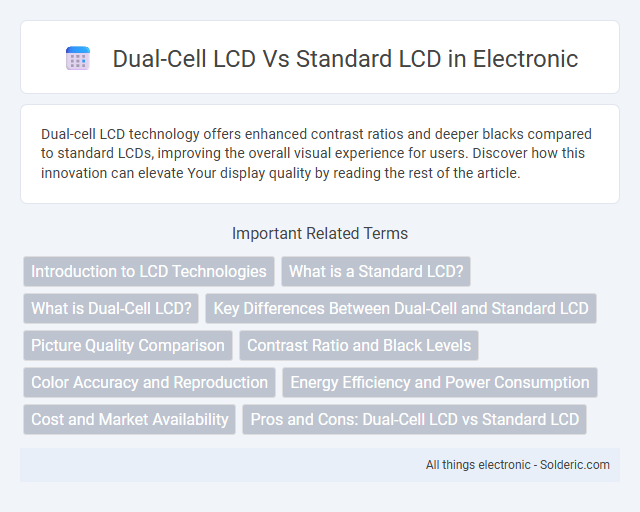Dual-cell LCD technology offers enhanced contrast ratios and deeper blacks compared to standard LCDs, improving the overall visual experience for users. Discover how this innovation can elevate Your display quality by reading the rest of the article.
Comparison Table
| Feature | Dual-Cell LCD | Standard LCD |
|---|---|---|
| Backlight Technology | Two-cell backlight system for enhanced brightness | Single backlight system |
| Contrast Ratio | Higher contrast, deeper blacks | Standard contrast levels |
| Color Accuracy | Improved color precision and range | Good but less precise |
| Viewing Angles | Wider viewing angles with minimal color shift | Limited viewing angles |
| Power Consumption | Moderate, due to dual backlights | Lower power usage |
| Use Cases | High-end monitors, TVs needing superior image quality | Consumer-grade displays, budget screens |
| Cost | Higher manufacturing cost | More affordable |
Introduction to LCD Technologies
Dual-Cell LCD technology leverages two liquid crystal layers to significantly enhance contrast ratios, color accuracy, and viewing angles compared to Standard LCDs that utilize a single liquid crystal layer. This advanced layering allows Dual-Cell LCDs to achieve deeper blacks and better local dimming control, making them ideal for HDR content and professional-grade displays. Standard LCDs, while cost-effective and widely used, often suffer from limited contrast and color reproduction due to their simpler structure and backlight control.
What is a Standard LCD?
A Standard LCD (Liquid Crystal Display) utilizes a single cell layer to modulate light and produce images, common in smartphones, TVs, and monitors. It offers adequate brightness and color accuracy but can struggle with visibility under direct sunlight and slower response times compared to advanced displays. Understanding your device's display technology helps optimize viewing experience and battery efficiency.
What is Dual-Cell LCD?
Dual-Cell LCD technology uses two liquid crystal layers to improve light control and reduce motion blur, resulting in sharper images and better contrast compared to standard LCDs. This innovation enhances your viewing experience, especially during fast-moving scenes, by significantly reducing ghosting and improving black levels. Dual-Cell LCDs offer a more vibrant and clear display, making them superior for gaming, sports, and high-definition video content.
Key Differences Between Dual-Cell and Standard LCD
Dual-Cell LCD technology utilizes two liquid crystal layers to enhance contrast ratios and improve black levels compared to standard LCDs, which use a single liquid crystal layer. The key difference lies in Dual-Cell's ability to reduce light leakage and provide deeper blacks, resulting in superior picture quality and more vibrant colors. Your viewing experience benefits from this advanced technology, especially in high dynamic range (HDR) content where contrast performance is critical.
Picture Quality Comparison
Dual-Cell LCD technology significantly enhances picture quality by utilizing two LCD layers to improve contrast ratios and reduce light leakage, resulting in deeper blacks and more vibrant colors compared to Standard LCDs. This configuration minimizes motion blur and delivers superior HDR performance, offering a sharper and more dynamic viewing experience. Standard LCDs typically struggle with lower contrast and washed-out colors, making Dual-Cell LCDs a preferred choice for high-fidelity visual content.
Contrast Ratio and Black Levels
Dual-Cell LCD technology significantly enhances contrast ratio and black levels by utilizing two liquid crystal layers to better block backlight, resulting in deeper, true blacks compared to Standard LCDs. This improvement reduces light bleed and halo effects, providing richer image depth and sharper details in dark scenes. For your viewing experience, Dual-Cell LCDs deliver superior visual quality, especially in environments with controlled lighting.
Color Accuracy and Reproduction
Dual-cell LCD technology offers superior color accuracy and reproduction compared to standard LCDs by utilizing two liquid crystal layers to enhance contrast and reduce light bleed. This results in deeper blacks and more vibrant, true-to-life colors, making images appear sharper and more detailed. You will notice much richer color fidelity, especially in high-dynamic-range content, when choosing dual-cell LCD displays.
Energy Efficiency and Power Consumption
Dual-Cell LCD technology significantly improves energy efficiency compared to Standard LCDs by utilizing two liquid crystal layers to enhance light modulation, reducing the need for high backlight intensity. This advanced design lowers power consumption, making it ideal for devices seeking extended battery life without compromising display brightness or clarity. You can enjoy vivid visuals while benefiting from reduced energy usage, especially in portable electronics.
Cost and Market Availability
Dual-cell LCDs typically incur higher production costs due to complex layering technology, resulting in a higher retail price compared to standard LCDs. Market availability of dual-cell LCDs is limited, often targeting premium segments such as high-end monitors and TVs, whereas standard LCDs dominate mass-market consumer electronics because of widespread manufacturing and cost efficiency. The premium pricing and niche focus restrict dual-cell LCD adoption despite superior display performance benefits.
Pros and Cons: Dual-Cell LCD vs Standard LCD
Dual-Cell LCD technology offers superior contrast ratios and better black levels compared to Standard LCDs, enhancing your viewing experience in dark scenes while reducing motion blur and improving overall image clarity. However, Dual-Cell LCDs tend to be more expensive and slightly thicker due to the additional liquid crystal layer, which can impact device design and cost. Standard LCDs remain more affordable and widely available but typically struggle with lower contrast ratios and slower response times relative to Dual-Cell LCD displays.
Dual-Cell LCD vs Standard LCD Infographic

 solderic.com
solderic.com